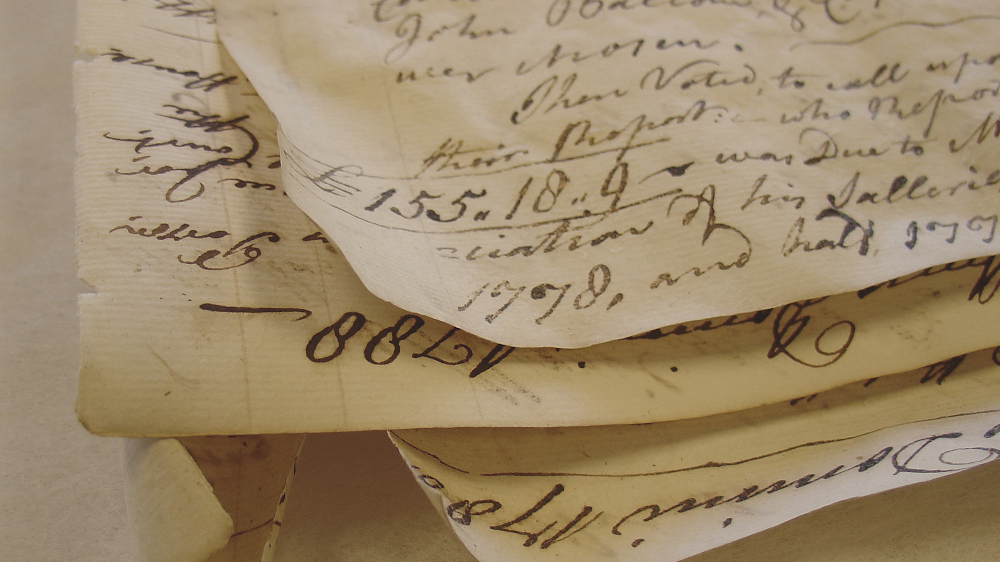Document Conservation
This resource guide introduces conservation concepts to support the care of documents in historical collections. It links to instructional resources that provide DIY preventive conservation techniques you can employ with little training and limited resources. It also recommends how to seek a conservator to conduct repair and treatment of particularly at-risk objects.
Terms
Several terms define the ways in which we care for our collections:
Conservation: This term can be used in two ways. It can either refer to all strategies relating to the care of cultural property or specifically to strategies that repair and stabilize cultural property. When referred to as conservation treatment, this only includes repair and stabilization strategies. Conservation treatment must be performed by a trained conservator.
Preventive Conservation: The prevention of harm to cultural property through activities that reduce deterioration, damage, and loss. It may also be referred to as preservation and does not include repair and stabilization.
DIY Stabilization & Recovery: A phrase used in this leaflet to describe actions that stabilize collections but may be appropriate for a non-conservator to carry out.
For one helpful way to understand preservation and conservation, see this Preservation vs. Conservation resource by NEDCC.
Preventive Conservation
Caring for Paper Objects, Canadian Conservation Institute (CCI)
This is a wholistic guide to improving the preservation outlook of paper. It is well structured, first covering the ways paper and the media on paper such as ink deteriorate then causes of damage due to external factors and finally recommendations on how to address these threats.
Sustainable Preservation Practices for Managing Storage Environments Webinars, Image Permanence Institute (IPI)
These webinars represent current, best-practice guidance on one of the most impactful preservation strategies a small historical organization can implement, ensuring a safe environment for documents that slows down deterioration. Covering beginner- and advanced-level guidance on the subject, these webinars walk the viewer through creating, monitoring, and managing a sustainable storage environment for collections with helpful visuals and authoritative instructors.
Conserve O Gram 19/16 Housing Archival Paper-based Materials, National Park Service (NPS)
This resource provides clear, step-by-step instructions for placing document collections into acceptable housing for long-term storage, an essential practice for historical organizations.
Preservation Self-Assessment Program Collection ID Guide, University of Illinois Urbana-Champaign
This guide helps readers identify various types of paper document formats and the media on those documents. Once identified, the resource helps the reader tailor their storage and handling of the material in their collection with specific, actionable, guidelines. It is a particularly helpful tool given the wide variety of paper formats that can be found in document collections.
DIY Stabilization & Recovery
Field Guide to Emergency Response Supplementary Resources, Foundation of the American Institute for Conservation (FAIC)
These videos provide a visual and comprehensive guide to dealing with disasters and cover topics that include initiating response and recovery and addressing water, mold, mud, bleeding dyes, corrosion, soot and ash, broken objects, pests, and hazardous materials.
Conserve O Gram 13/2 How to Flatten Folded or Rolled Paper Documents, National Park Service (NPS)
This Conserve O Gram walks through recommended steps to flatten rolled and folded documents using humidification, which improves access to and the preservation outlook of documents. Importantly, the resource also instructs the reader to contact a conservator to ensure the items are appropriate to humidify. Many factors, including type of media on the paper’s surface, can influence the impact of humidification on the object.
Preservation Leaflet 7.2 Surface Cleaning of Paper, NEDCC
This leaflet instructs the reader on how to remove dust and debris, mold, insect droppings and deposits, as well as sticky substances from paper. It also highlights when to seek a conservator or a recovery vendor and when to avoid surface cleaning entirely due to risk of damaging the object.
Preservation Leaflet 7.8 Removal of Damaging Fasteners from Historic Documents, NEDCC
This brief guide to removing paper clips, staples, and straight pins uses clear pictures and text to help the reader address dangerous fasteners in their collections.
Frequently Asked Preservation Questions, NEDCC
While technically covering topics that include preventive conservation, NEDCC’s FAQ guide includes a particularly useful DIY recovery strategy: the removal of musty smell from books, which is also appropriate for documents and is relatively easy to implement for small historical organizations.
Conservation Treatment
Find a Conservator Tool, American Institute for Conservation (AIC)
This tool helps organizations locate professional members of the American Institute for Conservation by specialty and geographic location. While the basic search option can yield a good list of results for an organization to consider, the advanced search can help an organization narrow down specialty even further and is helpful when searching for a material or service not explicitly listed in the basic search.
Preservation Leaflet 7.7 Choosing and Working with a Conservator, NEDCC
This guide provides the reader with basic information about the conservation field and helps the reader select a qualified conservator for the treatment and repair of their documents.
This resource guide has been curated by Northeast Document Conservation Center (NEDCC).

